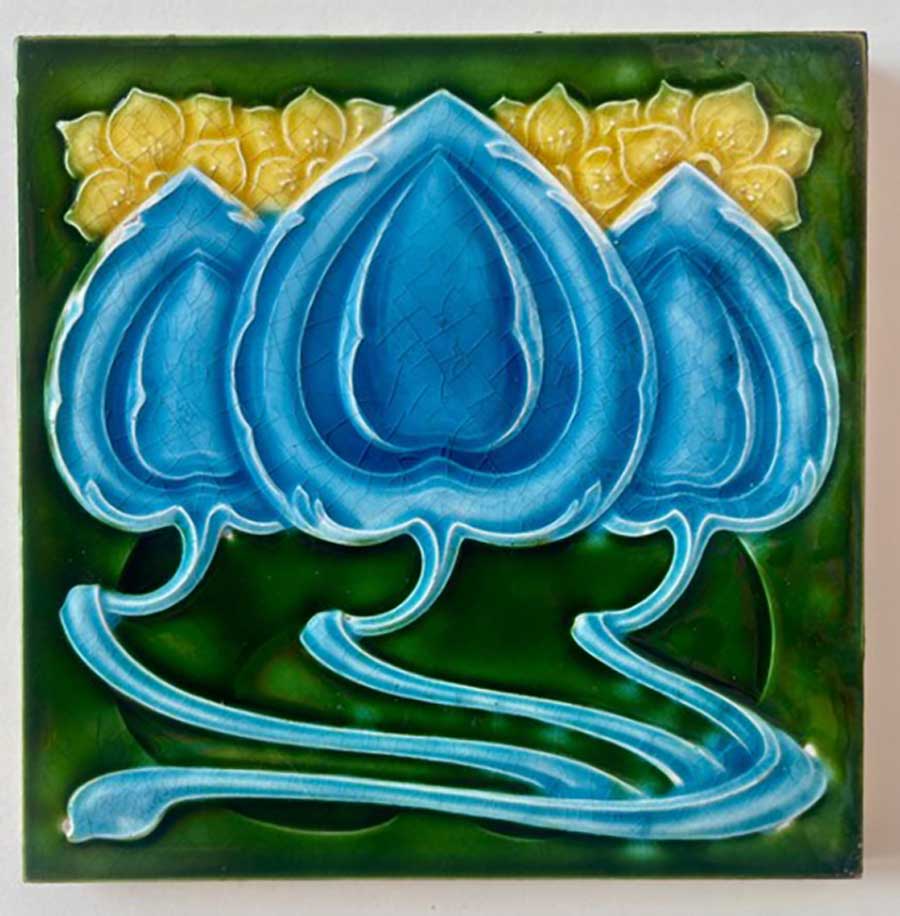September 2025
Good Eye
Laying down a Tile
by Peggy Whiteneck
Wall tiles aren’t just an antique decorative accent but a treat for modern collectors. They have a long history: Ancient tiles were being used for paving various surfaces as early as centuries before Christ. But most of the oldest wall tiles seen today date from the 1880s and have become collectible in their own right as well as sought after for home décor. Some older tiles were made of metal, but collector interest today is focused on the ceramic tiles. They were originally used as backing behind stove pipes, as flooring, or as decorative accents in hallways or around doors. These inlaid tiles were described using the adjective “encaustic.” As described on Giovanni’s Tile Design web site, giovannistile.com/blog/the-history-of-decorative-tiles, encaustic tile combines a plain clay base with a stamped area that is filled with colored liquid clay and fired to fuse the different layers together. These encaustic figural art motifs are the tiles of most interest to collectors today.
Antique ceramic tiles were usually about a half inch thick vs. a quarter inch for modern tiles. Still, the thicker width of old tiles did not protect them from damage; it is often difficult to find undamaged tiles today, especially sets of matching older tiles for contemporary home renovation projects. Damage could happen over time while the tiles were in place, or they could be damaged in the process of dismantling and removing them. Tiles taken directly from walls will often have on their backs the cement used to install them, which prevents identification of the maker’s mark and patent and pattern numbers that are usually included on the backs of the original tile. Collectors prefer clean backs that reveal these manufacturing details.
Manufacturers Worldwide and Close to Home
Decorative tiles were a worldwide manufacturing phenomenon. Most of the more famous tile manufacturers were based in the United States, England, Portugal, Morocco, and Japan. Over time, the term “Moroccan” has been used to denote a style rather than a point of origin. But the most famous and original Moroccan tile maker is Zellig, which was actually founded in Morocco and has been functioning for centuries right up until today.
Perhaps the most famous of American decorative tile companies was the J. & J.G. Low Co., founded in Chelsea, MA, in 1877; it closed in 1902. Other American companies founded in the late 1880s included the American Encaustic Tiling Co. in Zanesville, OH (which later morphed into the Shawnee Co.) and Grueby Faience Co. in Revere, MA (closed in 1921). The backs of American Encaustic tiles are marked simply with the company’s initials A.E. (An English company called Alfred Meakin from the 1920s is also marked simply with initials A.M. The use of just the initials may seem to us today a bit of braggadocio by companies so proud of their work they didn’t even have to use the whole name, but it’s more likely that early tile making was restricted to just a few companies, making the use of the initials more readily identifiable at the time).

Alfred Meakin wall tile
This Alfred Meakin wall tile sold on eBay in July for $200. It is marked on the verso AM LTD ENGLAND. Meakin also made border tiles for outlining room surfaces that are sought-after collectibles today. Scarcity of a tile pattern will affect its value, and you can still find figural Meakin tiles for less than $50. Image courtesy of the author
In England, Minton’s China Works was founded in 1868 and closed in 1918, and Alfred Meakin, Ltd. was founded in 1875 and functioned under Alfred and, later, his son until the son’s death in 1908. The Meakin tiles had gorgeous floral and flowing forms in their Art Deco design. A Japanese company, Danto Kaisha, also working in the Art Deco style in this period, marked its tiles solely with its initials D.K. Another company in Japan working in the Art Deco style also identified its tiles by its initials, M.S.
Well after these older companies folded, a number of 20th-century manufacturers stepped in to create ceramic tiles still available for home projects today. Most examples of antique tiles remain affordable (many under $100 each) though a few of the rarer examples may cost several hundred dollars. Find your own tiles with style!
Peggy Whiteneck is a writer, collector, and dealer living in East Randolph, VT. If you would like to suggest a subject that she can address in her column, email her at allwritealready2000@gmail.com.

